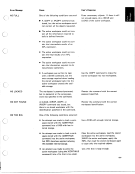, [rl
The rfunction: Ceiling, Maximum
Monadic (One-Argument) Form: Ceiling r B
The ceiling function result is the next integer larger than the argument (the argument
is rounded up), unless the argument already is an integer. In this case, the result is
the same as the argument. The argument can be a numeric scalar, vector, or other
array. The shape of the result is the same as that of the argument:
If the argument is an array, the function is extended to each of the elements:
1-1-2 1 ,J 1. ,s 2
B
1. 1. I 3
1.5 d"
'1
I"B
1. 2
2 2
Note: The result of the ceiling function depends on the OCTsystem variable (see
Chapter 5 for information on the OCT system variable).
Dyadic (Two-Argument) Form: Maximum Ar B
The maximum function result is the larger of the arguments. The arguments can be
numeric scalars, vectors, or other arrays. The arguments must be the same shape un-
less one of the arguments is a scalar or any single-element array. Arguments of the
same shape have the same shape result:
". ,
60
The rfunction: Ceiling, Maximum
Monadic (One-Argument) Form: Ceiling r B
The ceiling function result is the next integer larger than the argument (the argument
is rounded up), unless the argument already is an integer. In this case, the result is
the same as the argument. The argument can be a numeric scalar, vector, or other
array. The shape of the result is the same as that of the argument:
If the argument is an array, the function is extended to each of the elements:
1-1-2 1 ,J 1. ,s 2
B
1. 1. I 3
1.5 d"
'1
I"B
1. 2
2 2
Note: The result of the ceiling function depends on the OCTsystem variable (see
Chapter 5 for information on the OCT system variable).
Dyadic (Two-Argument) Form: Maximum Ar B
The maximum function result is the larger of the arguments. The arguments can be
numeric scalars, vectors, or other arrays. The arguments must be the same shape un-
less one of the arguments is a scalar or any single-element array. Arguments of the
same shape have the same shape result:
". ,
60









































































































































































































































